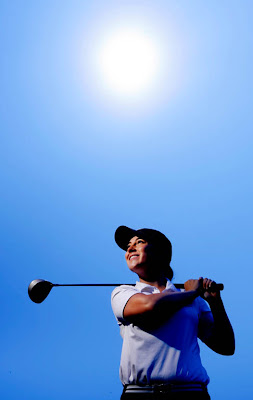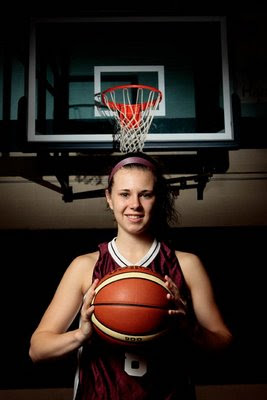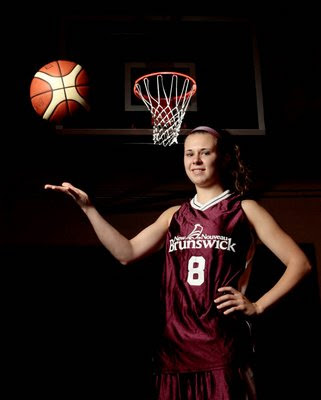 Today’s athlete shoot is of softball player Sam DeBortoli.
Today’s athlete shoot is of softball player Sam DeBortoli.
This was the second baseball/softball related shoot that I did, so I started up with something different.
(233)
 Today’s Canada Games Athlete portrait is of golfer Jennifer Armstrong. This was actually the first shoot done for this series. I shot her at the Riverside Golf and Country Club where she is a member.
Today’s Canada Games Athlete portrait is of golfer Jennifer Armstrong. This was actually the first shoot done for this series. I shot her at the Riverside Golf and Country Club where she is a member.
So the first day of shooting, the weather was overcast and spitting rain a tiny bit. Not what I was hoping for, but that’s the light I had.
To be able to control the light on Jennifer, I metered from the bright sky. That made her go dark, allowing me to add the light I wanted with the flash.
But how did I get the blue sky instead of the gray overcast? This is done using a neat technique combining white balance and filters for the flash.
I set the WHITE BALANCE (WB) on the camera to TUNGSTEN/INCANDESCENT (the little glowing round bulb). This adds extra blue to the image to correct for the yellow light given off by that type of light. However, because this is daylight, everything just turns blue.

So, when I turn on the flash to fill in the light, since the flash is DAYLIGHT balanced, it goes completely blue as well.

So, to warm the light of the flash up, I placed a CTO gel over the flash head. This filter is orange and converts DAYLIGHT to TUNGSTEN.

Where can you get this filter? Well, you can get it for free from Lee Filters! They make colored filters for stage lighting, and put out a sample pack containing hundreds of filters so you can see all the various colors and effects. These samples also just happen to completely cover the flash head! If you contact Lee filters, (Canada here, US here) they will send you a pack for free! Or if you are in SJ, send me an email and I can hook you up. I have a box of em from the company.

As I was shooting, I saw how the leaves of the tree made for an interesting framing element, so I began to incorporate them into the composition.


I then wanted to try incorporating the sun into the frame. The sun was a bit higher in the sky, so I had Jennifer stand on the 18th green and I was down at a lower angle so I could get the sky at the top of the frame.

Since the ambient light was lower, it gave me the opportunity to try out some slower shutter speeds(1/30th-1/15th of a second at 100 ISO) and do some rotating, panning and zooming the camera during the exposure to get interesting blur. Since Jennifer was completely back lit by the sky, she is completely sharp as the only light on her is from the flash.

Then I tried some on the normal white balance without the gel, and I really liked how they turned out.


To see more in this series, head to my Canada Games Athlete Galleries on my site that contains more images from this shoot.
To see the full series of posts in the Canada Games Series, click here.
Next up on Monday should be softball. Not sure though because I didn’t get my paper!!!
(211)
 Today’s New Brunswick Canada Games team member is basketball player Laura McCaffrey. Being indoors gives you total control over the light, as you can use the flashes at higher power levels to overpower the ambient light, or turn the lights down or off indoors!
Today’s New Brunswick Canada Games team member is basketball player Laura McCaffrey. Being indoors gives you total control over the light, as you can use the flashes at higher power levels to overpower the ambient light, or turn the lights down or off indoors!
I had previously done an interesting shot of another player where I light up the backboard with one flash and used another one on her, so I thought I’d try it again.

Since I could bring the lights closer and didn’t need full power to match the ambient sunlight as with other shoots, I used an umbrella on her to soften the light. I still found the light on the backboard was too bright and contrasty, so I decided to try something. I place a flash directly underneath the net pointed straight up, which resulted in this:
Definitely made for a cooler light! So I used that set up instead to light up the backboard and it provided much better results.


The old toss up the ball is a staple of mine, as the sports editor will tell you. You’ve already seen some with the softball people, and trust me, you will see more.

I then decided to try to incorporate another element, the scoreboard.
For this shoot, I had turned off the lights on the half of the gym I was working on to prevent any of the lovely gym light ambient from turning my subject orange/red. The scoreboard is bright enough to stand out.

The to add a sense of movement, I tried some shots using zooming, rotating, and panning the lens at a slower speed, anywhere from 1/30th of a second to 1/8th of a second. As you can see with the one below, even though I have the lights off on this side of the gym, the slower speed is picking up some of the ambient light from the other side which started adding some red/orange to the image.


I finished off with bringing Laura farther out from the basket, which allowed me to leave some black space and worked out nice too. One of these ended up running the full height of the page, looked pretty cool!

To see more in this series, head to my Canada Games Athlete Galleries on my site that contains more images from this shoot.
To see the full series of posts in the Canada Games Series, click here.
Next up, golfer Jennifer Armstrong, who was the first shot I did for the series!
(211)
 The second portrait in the series is of Team New Brunswick sailors Alex Black(l) and Kelvin Gilliland, one of the few multi-person shoots. They can be a bit of a challenge as you are trying to get both people into the composition along with the equipment/background, etc that tells their story.
The second portrait in the series is of Team New Brunswick sailors Alex Black(l) and Kelvin Gilliland, one of the few multi-person shoots. They can be a bit of a challenge as you are trying to get both people into the composition along with the equipment/background, etc that tells their story.
The set up is the same as the previous series. Set the subjects up so they are backlit by the sun, then light them up with the flash. The image below, I’ve metered for the background ambient exposure to give me good sky(in this case 1/250th of a second at F16, ISO 100)

Then, turn on my frankenstein flash monster(three flashes velcro taped together again!) and adjust the power as necessary, and voila!

This shoot provided a few challenges. The first trying to get both guys and the sailboat in the frame. Normally it would be easy enough to have them stand close to the camera and have the other elements farther in the background. In this case however, the boat couldn’t stay still as it was on the boat ramp but in the water. So I needed to have them close so they could keep the boat in the right position as well as prevent it from being damaged or start floating away.
The second was that while I was trying to shoot, in behind people were bringing their boats down to put them in the water! C’mon people, can’t you see the photo shoot going on here!!!
For some of the images, I decided to use the sun as part of the composition, and it really worked out well. Loved the flaring and the startburst of the sun, something you needed a filter for back in the old film days, but it seems to me that you get that effect any time you put the sun in the frame with a digital.

As always, trying horizontals and verticals to see which angle works best, getting closer in, farther away, changing lenses. Every shoot you want to try lots of different options, especially since editors love having choices!




To see more in this series, head to my Canada Games Athlete Galleries on my site that contains more images from this shoot.
To see the full series of posts in the Canada Games Series, click here.
Next up is a basketball player, where shooting indoors can really end up with some great lighting! Stay tuned!
(210)
 The New Brunswick Canada Games athlete articles have started, so I can now start posting some pix from the shoots. The first story is about Nicole Barry, who is playing on the women’s softball team for this year’s games in Prince Edward Island, and her grandmother Marlene Vaughan, who competed in softball in 1969.
The New Brunswick Canada Games athlete articles have started, so I can now start posting some pix from the shoots. The first story is about Nicole Barry, who is playing on the women’s softball team for this year’s games in Prince Edward Island, and her grandmother Marlene Vaughan, who competed in softball in 1969.
The idea for this series was to do really cool portraits, which meant being able to take the time to do it right. Even before the shoot I tried to think up ideas for each athlete that would be better than the normal shots we take. This meant using flash, poses, and backgrounds in a more creative way.
I was also fortunate to have an assistant for many of the shoots, Tanner Cheeseman, who was an awesome assistant, especially considering I couldn’t pay him (but as the ad says, the experience was PRICELESS) You can view some of his work here. I also have to thank the editors for giving me 45 minutes to an hour for each shoot. That also means a big thanks to the athletes themselves for their patience with me!
So enough background, let’s talk photo technical stuff!
One of the key things to using light effectively is being able to control it. While the bright light from the sun is usually great to have, the problem with sun is, you can’t control it. So when at all possible, you need to block it from the subject. This could be by having them backlit by the sun or having them in complete shade, which allows you to add the light with the flash.
The only problem when mixing flash and a full sun background is the large amount of light needed from the flashes to match the sun. This is where this baby comes in:

 Yep…that three Canon flashes held together with a roll of velcro tape(if only Red Green knew about this stuff-I swear it is waaaaay better than duct tape!) You are wondering, why do you need so much power? Well, it’s because of the large amount of light I’m trying to match. The ambient exposure for full sun would be 1/250th of a second at F22 with ISO 400…at F22 at full power, the flash will only reach 1 meter if I’m lucky. Throw in two flashes at full power, we’ve got 2 meters of range. Three, make it 3 meters! For many of the shoots I didn’t need the flashes to be that far away, but some I did.
Yep…that three Canon flashes held together with a roll of velcro tape(if only Red Green knew about this stuff-I swear it is waaaaay better than duct tape!) You are wondering, why do you need so much power? Well, it’s because of the large amount of light I’m trying to match. The ambient exposure for full sun would be 1/250th of a second at F22 with ISO 400…at F22 at full power, the flash will only reach 1 meter if I’m lucky. Throw in two flashes at full power, we’ve got 2 meters of range. Three, make it 3 meters! For many of the shoots I didn’t need the flashes to be that far away, but some I did.

They are being triggered via Pocket Wizards, which are wireless transceivers that work way better than the Canon wireless flash system, which frankly…sucks!(I’ll be putting together a really long blog about this fact later, especially after some frustrations with these shoots and the Canon flashes) I just picked up the pocket wizards a few months ago, and I don’t know how I survived without them. (For anyone who has them, I used a simple headphone line splitter so I could trigger two flashes with one pocket wizard. Works fine as long as the flashes are the same type and voltage)
So here’s how it’s done.
1) Set up the subjects in the shade of the stands at Canada Games Stadium in Saint John.
2) Using the highest shutter speed possible when using flash (in this case, 250th. Most other cameras will be 1/200th or slower), balance the meter in MANUAL mode by selecting the proper aperture.
3) Turn on the flashes and position them to provide the right angle of light, and fire away! If the flashes are too bright, push them back or turn the power down. If they aren’t bright enough, bring them close to the subjects.
The main image was my fav, here are some other poses I liked.


I also tried one with the Canada Games Stadium in the background. The problem here was that then they would be in the shade, and the words above them would also be shade. That meant no control over the light. So in order to get the same type of directional light with the flash, I had to overpower the shade with flash. This however meant the Canada Games Stadium would be too dark, so I had Tanner hold up a flash in the background to light up the letters.
 To see more in this series, head to my Canada Games Athlete Galleries on my site that contains more images from this shoot.
To see more in this series, head to my Canada Games Athlete Galleries on my site that contains more images from this shoot.
To see the full series of posts in the Canada Games Series, click here.
(443)
One of the best things about being a newspaper photographer is that I get to meet lots of interesting people who do lots of interesting things. I was given the assignment to photograph a Luthier. What’s A Luthier I thought to myself…
(309)